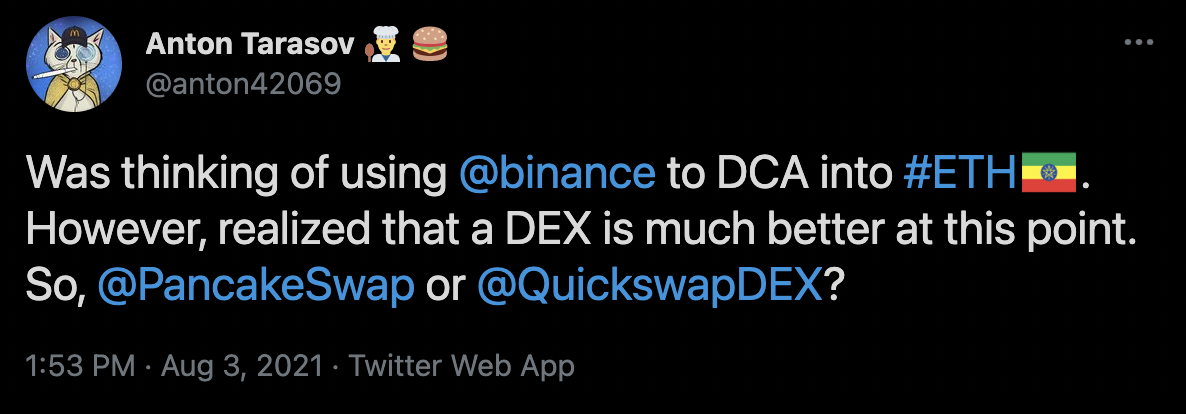Kick your Binance addiction.

You can free yourself from your dependence on the big exchanges.
I will admit, I have been hooked on Binance for years. It’s cheap and convenient—but it comes at a price.
There’s a common saying in crypto: not your keys, not your coins. Even for Binance this rings true. Quadriga, Cryptopia, and Mt. Gox have taught old-timers that even the most reputable of exchanges can wither to the test of time.
That said, exchanges are unavoidable. There are a few simple things you can do to limit your risk and make sure you end up on the right side of a hack.
Today, I will share how you can curb your centralized exchanges habit and dollar-cost average into your favorite coin while keeping complete control over your funds.
Dollar-cost averaging (DCA) is a great way to make long-term investments. I won’t go into the details about why it is great, but an article titled “Even God Couldn’t Beat Dollar-Cost Averaging” sums it up in its name alone.
To keep it short, dollar-cost averaging minimizes the impact of volatility. By buying assets in small daily doses, a big dip or sudden surge won’t shake up your plans.
Previously, the only way to DCA was on a centralized exchange like Binance. It wasn’t possible to replicate such a strategy on Ethereum because of exorbitant transaction fees. Until now, that is.
With the advent of L2 and interoperability between chains, you can escape Ethereum’s crippling fees. Below I will share the best solutions I have discovered.
At the start of my research, I asked people on my Twitter feed for their recommendations. My initial hypothesis was that Binance Smart Chain or Polygon would be the go-to options.

Despite popular belief, I am not a chain-smoking cat in real life.
Later, I would discover both BSC and Polygon had their issues.
The bridges to Ethereum are the crux of the problem. The bridges on both networks are centralized. Although the networks themselves are better than centralized exchanges in terms of asset control, the bridges diminish this benefit.
In theory, there is nothing to stop Binance from complicating the bridge between BSC and Ethereum for its own gain. I suspect they even have an incentive to do just that.
It is no secret that Binance sucker-punched Ethereum when it was reeling from congestion. When gas prices declined, Binance still kept its ERC-20 withdrawal fees high, encouraging people to withdraw to BSC.
Polygon isn’t much better. The teams responsible for the network’s bridge came under heavy criticism. Once funds enter the bridge, these teams have unchecked control over your money. Out of principle such a setup is unsettling to me, even if these teams never exploit their control.
Next up, I tried using PancakeSwap on BSC and QuickSwap on Polygon to buy ETH. Although it wasn’t too much hassle, the prices were not ideal. Neither of these decentralized exchanges have a price feed, so their prices are a product of constant arbitration. As such, it is no match for Binance’s deep order books.
While a $10 difference isn’t too bad when you’re making a one-off investment, it is a major problem when you’re making lots of small buys. In conclusion, even the top Ethereum-cloned decentralized exchanges are inferior to Binance.
To top it off, you still have to pay transaction fees. While they are relatively cheap, making hundreds of transactions a month ends up costing a lot of money.
I wasn’t impressed after trying out PancakeSwap and QuickSwap. It seemed that decentralized exchanges were still not ready to unseat the Binances and Coinbases of the world. Even though they have tremendously evolved over the past months.
And the story would have ended there. But then my teammate Vishal reminded me about Loopring and DiversiFi.
Both exchanges are Layer 2 solutions that use advanced cryptography (zero-knowledge proofs) to ensure that transactions are private. They don’t even need bridges, so you don’t give up on asset security either. Also, they are not exposed to gas fees. So we’re off to a good start!
Although I didn’t like Loopring’s interface, the prices offered were pretty close to Binance’s. DiversiFi provides a similar experience but with a slick interface.
I paid about $20 to get my money in and out of DiversiFi when gas prices were about 30 gwei. These fees are comparable to ERC-20 withdrawal fees on Binance.
On top of that, the exchange recently launched a bridge to Polygon. So if you can’t find a coin on DiversiFi, you can withdraw your assets to Polygon (for pennies) and conduct your trades there. Once you finish up you can bring your funds back to DiversiFi. Funny enough, DiversiFi is less hassle than Polygon’s ‘official’ bridge.
So we have a winner folks. DiversiFi is my go-to place for decentralized dollar-cost averaging.
In 2021 you can opt-out of Binance and Coinbase and dollar-cost average into your favorite assets. Although you will mostly be restricted to large-caps like BTC and ETH, the number of assets available will only grow each passing month.
So it’s time to kick your Binance addiction and take control of your coins.
If you’re interested in more insights like this, follow us on Twitter for free reports and tips from the team.
Disclosure: The author of this newsletter holds ETH. Read our trading policy to see how SIMETRI protects its members against insider trading.
